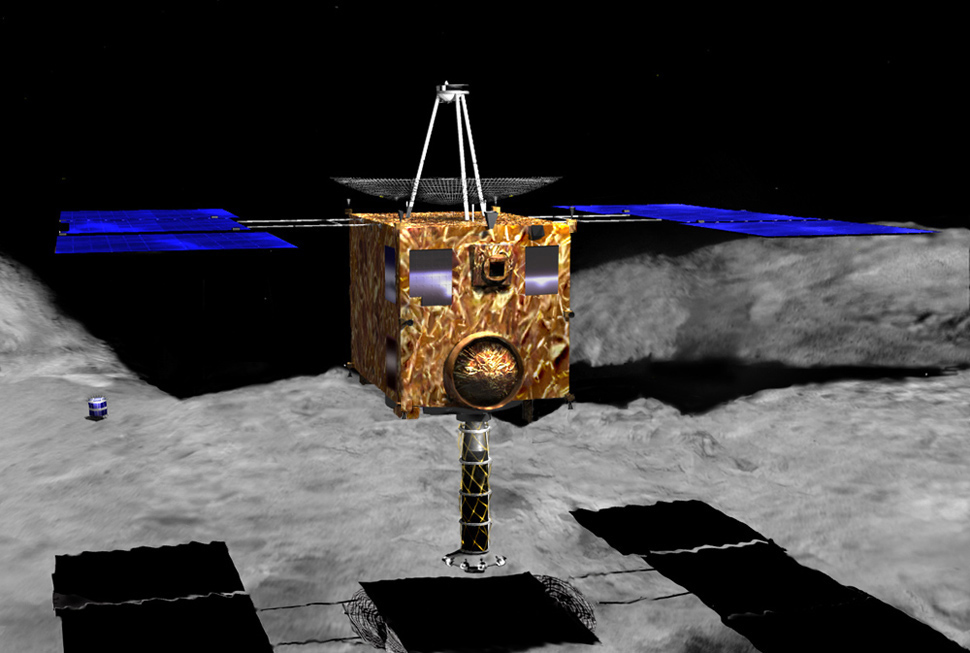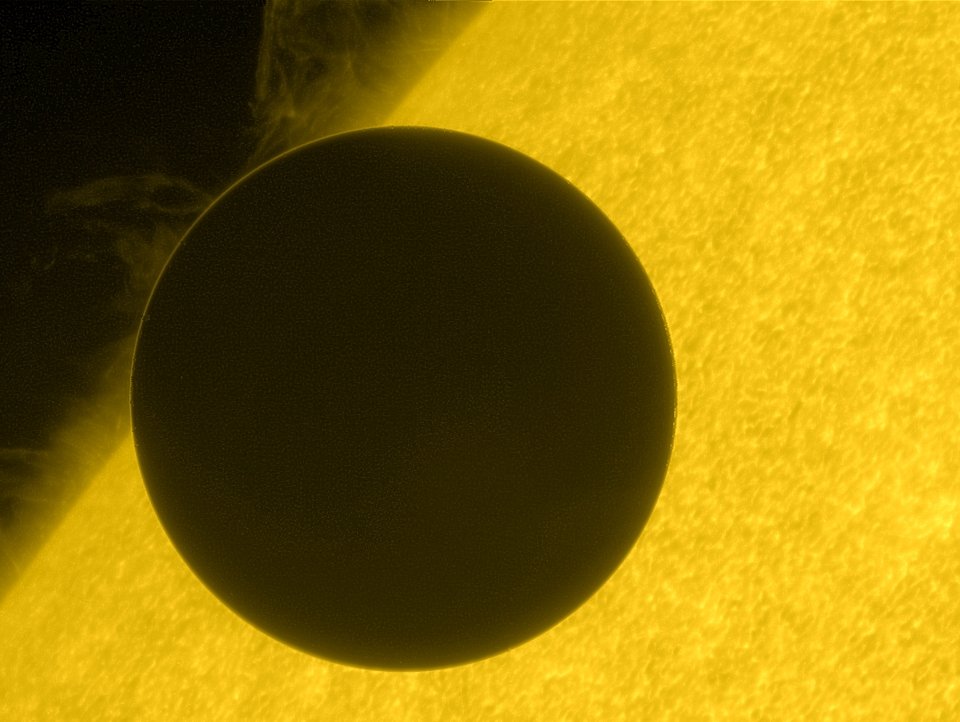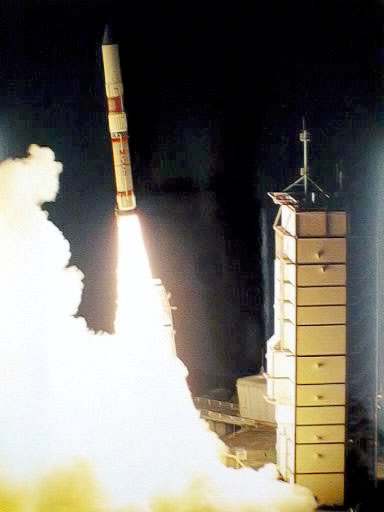|
M-V
The M-V rocket, also called M-5 or Mu-5, was a Japanese solid-fuel rocket designed to launch scientific satellites. It was a member of the Mu family of rockets. The Institute of Space and Astronautical Science (ISAS) began developing the M-V in 1990 at a cost of 15 billion yen. It has three stages and is high, in diameter, and weighs about . It was capable of launching a satellite weighing into an orbit as high as . The first M-V rocket launched the HALCA radio astronomy satellite in 1997, and the second the Nozomi Mars explorer in July 1998. The third rocket attempted to launch the Astro-E X-ray satellite on 10 February 2000 but failed. ISAS recovered from this setback and launched Hayabusa to 25143 Itokawa in 2003. The following M-V launch was the scientific Astro-E2 satellite, a replacement for Astro-E, which took place on 10 July 2005. The final launch was that of the Hinode (SOLAR-B) spacecraft, along with the SSSat microsat and a nanosatellite, HIT-SAT, on 22 Septe ... [...More Info...] [...Related Items...] OR: [Wikipedia] [Google] [Baidu] |
Mu (rocket Family)
The Mu, also known as M, was a series of Japanese solid-fueled carrier rockets, which were launched from Uchinoura between 1966 and 2006. Originally developed by Japan's Institute of Space and Astronautical Science, Mu rockets were later operated by Japan Aerospace Exploration Agency following ISAS becoming part of it. Early Japanese carrier rockets The first Mu rocket, the Mu-1 made a single, sub-orbital, test flight, on 31 October 1966. Subsequently, a series of rockets were produced, designated Mu-3 and Mu-4. In 1969 a suborbital test launch of the Mu-3D was conducted. The first orbital launch attempt for the Mu family, using a Mu-4S, was conducted on 25 September 1970, however the fourth stage did not ignite, and the rocket failed to reach orbit. On 16 February 1971, Tansei 1 was launched by another Mu-4S rocket. Two further Mu-4S launches took place during 1971 and 1972. The Mu-4S was replaced by the Mu-3C, was launched four times between 1974 and 1979, with three success ... [...More Info...] [...Related Items...] OR: [Wikipedia] [Google] [Baidu] |
ASTRO-EII
''Suzaku'' (formerly ASTRO-EII) was an X-ray astronomy satellite developed jointly by the Institute of Space and Aeronautical Science at JAXA and NASA's Goddard Space Flight Center to probe high energy X-ray sources, such as supernova explosions, black holes and galactic clusters. It was launched on 10 July 2005 aboard the M-V launch vehicle on the M-V-6 mission. After its successful launch, the satellite was renamed ''Suzaku'' after the mythical Vermilion bird of the South. Just weeks after launch, on 29 July 2005, the first of a series of cooling system malfunctions occurred. These ultimately caused the entire reservoir of liquid helium to boil off into space by 8 August 2005. This effectively shut down the X-ray Spectrometer-2 (XRS-2), which was the spacecraft's primary instrument. The two other instruments, the X-ray Imaging Spectrometer (XIS) and the Hard X-ray Detector (HXD), were unaffected by the malfunction. As a result, another XRS was integrated into the Hitom ... [...More Info...] [...Related Items...] OR: [Wikipedia] [Google] [Baidu] |
ASTRO-E
''Suzaku'' (formerly ASTRO-EII) was an X-ray astronomy satellite developed jointly by the Institute of Space and Aeronautical Science at JAXA and NASA's Goddard Space Flight Center to probe high energy X-ray sources, such as supernova explosions, black holes and galactic clusters. It was launched on 10 July 2005 aboard the M-V launch vehicle on the M-V-6 mission. After its successful launch, the satellite was renamed ''Suzaku'' after the mythical Vermilion bird of the South. Just weeks after launch, on 29 July 2005, the first of a series of cooling system malfunctions occurred. These ultimately caused the entire reservoir of liquid helium to boil off into space by 8 August 2005. This effectively shut down the X-ray Spectrometer-2 (XRS-2), which was the spacecraft's primary instrument. The two other instruments, the X-ray Imaging Spectrometer (XIS) and the Hard X-ray Detector (HXD), were unaffected by the malfunction. As a result, another XRS was integrated into the Hitom ... [...More Info...] [...Related Items...] OR: [Wikipedia] [Google] [Baidu] |
Suzaku (satellite)
''Suzaku'' (formerly ASTRO-EII) was an X-ray astronomy satellite developed jointly by the Institute of Space and Aeronautical Science at JAXA and NASA's Goddard Space Flight Center to probe high energy X-ray sources, such as Supernova, supernova explosions, black holes and Open cluster, galactic clusters. It was launched on 10 July 2005 aboard the M-V launch vehicle on the M-V-6 mission. After its successful launch, the satellite was renamed ''Suzaku'' after the mythical Vermilion Bird, Vermilion bird of the South. Just weeks after launch, on 29 July 2005, the first of a series of cooling system malfunctions occurred. These ultimately caused the entire reservoir of liquid helium to boil off into space by 8 August 2005. This effectively shut down the X-ray spectroscopy, X-ray Spectrometer-2 (XRS-2), which was the spacecraft's primary instrument. The two other instruments, the X-ray Imaging Spectrometer (XIS) and the Hard X-ray Detector (HXD), were unaffected by the malfunction. ... [...More Info...] [...Related Items...] OR: [Wikipedia] [Google] [Baidu] |
Uchinoura Space Center
The is a space launch facility in the Japanese town of Kimotsuki, Kagoshima Prefecture. Before the establishment of the JAXA space agency in 2003, it was simply called the (KSC). All of Japan's scientific satellites were launched from Uchinoura prior to the M-V launch vehicles being decommissioned in 2006. It continues to be used for suborbital launches, and has also been used for the Epsilon orbital launch vehicle. Additionally, the center has antennas for communication with interplanetary space probes. History Established in February 1962, the Kagoshima Space Center (KSC) was constructed on the Pacific coast of Kagoshima Prefecture in Uchinoura (now part of Kimotsuki) for the purpose of launching large rockets with probe payloads. Prior to establishment of KSC, test launches of the Pencil Rocket, Baby Rocket and Kappa Rocket had been performed at the pioneering Akita rocket test facility ( Michikawa) from the mid-1950s to the 1960s. However, progress in rocket developm ... [...More Info...] [...Related Items...] OR: [Wikipedia] [Google] [Baidu] |
Hayabusa
was a robotic spacecraft developed by the Japan Aerospace Exploration Agency (JAXA) to return a sample of material from a small near-Earth asteroid named 25143 Itokawa to Earth for further analysis. ''Hayabusa'', formerly known as MUSES-C for Mu Space Engineering Spacecraft C, was launched on 9 May 2003 and rendezvoused with Itokawa in mid-September 2005. After arriving at Itokawa, ''Hayabusa'' studied the asteroid's shape, spin, topography, color, composition, density, and history. In November 2005, it landed on the asteroid and collected samples in the form of tiny grains of asteroidal material, which were returned to Earth aboard the spacecraft on 13 June 2010. The spacecraft also carried a detachable minilander, ''MINERVA'', which failed to reach the surface. Mission firsts Other spacecraft, notably ''Galileo'' and ''NEAR Shoemaker'' (both launched by NASA), had visited asteroids before, but the ''Hayabusa'' mission was the first attempt to return an asteroid samp ... [...More Info...] [...Related Items...] OR: [Wikipedia] [Google] [Baidu] |
AKARI
Akari (ASTRO-F) was an infrared astronomy Infrared astronomy is a sub-discipline of astronomy which specializes in the observation and analysis of astronomical objects using infrared (IR) radiation. The wavelength of infrared light ranges from 0.75 to 300 micrometers, and falls in betwee ... space observatory, satellite developed by Japan Aerospace Exploration Agency, in cooperation with institutes of Europe and Korea. It was launched on 21 February 2006, at 21:28 Coordinated Universal Time, UTC (06:28, 22 February Japan Standard Time, JST) by M-V rocket into Earth sun-synchronous orbit. After its launch it was named ''Akari'' (明かり), which means ''light'' in Japanese. Earlier on, the project was known as IRIS (InfraRed Imaging Surveyor). Its primary mission was to survey the entire sky in near-, mid- and far-infrared, through its aperture telescope. Technical design Its designed lifespan, of far- and mid-infrared sensors, was 550 days, limited by its liquid helium co ... [...More Info...] [...Related Items...] OR: [Wikipedia] [Google] [Baidu] |
Hinode (satellite)
Hinode (; ja, ひので, , Sunrise), formerly Solar-B, is a Japan Aerospace Exploration Agency Solar mission with United States and United Kingdom collaboration. It is the follow-up to the Yohkoh (Solar-A) mission and it was launched on the final flight of the M-V rocket from Uchinoura Space Center, Japan on 22 September 2006 at 21:36 UTC (23 September, 06:36 JST). Initial orbit was perigee height 280 km, apogee height 686 km, inclination 98.3 degrees. Then the satellite maneuvered to the quasi-circular sun-synchronous orbit over the day/night terminator, which allows near-continuous observation of the Sun. On 28 October 2006, the probe's instruments captured their first images. The data from Hinode are being downloaded to the Norwegian, terrestrial Svalsat station, operated by ''Kongsberg'' a few kilometres west of Longyearbyen, Svalbard. From there, data is transmitted by Telenor through a fibre-optic network to mainland Norway at Harstad, and on to data users ... [...More Info...] [...Related Items...] OR: [Wikipedia] [Google] [Baidu] |
HALCA
HALCA (Highly Advanced Laboratory for Communications and Astronomy), also known for its project name VSOP (VLBI Space Observatory Programme), the code name MUSES-B (for the second of the Mu Space Engineering Spacecraft series), or just Haruka (はるか) was a Japanese 8 meter diameter radio telescope satellite which was used for Very Long Baseline Interferometry (VLBI). It was the first such space-borne dedicated VLBI mission. History It was placed in a highly elliptical orbit with an apogee altitude of 21,400 km and a perigee altitude of 560 km, with an orbital period of approximately 6.3 hours. This orbit allowed imaging of celestial radio sources by the satellite in conjunction with an array of ground-based radio telescopes, such that both good (u,v) plane coverage and very high resolution were obtained. Although designed to observe in three frequency bands: 1.6 GHz, 5.0 GHz, and 22 GHz, it was found that the sensitivity of the 22 GHz band had ... [...More Info...] [...Related Items...] OR: [Wikipedia] [Google] [Baidu] |
Nozomi (spacecraft)
was a Mars orbiter that failed to reach Mars due to electrical failures. The mission was terminated on December 31, 2003. It was constructed by the Institute of Space and Astronautical Science, University of Tokyo and launched on July 4, 1998, at 03:12 JST (July 3, 1998, at 18:12 UTC) with an on-orbit dry mass of 258 kg and 282 kg of propellant. ''Nozomi'' was designed to study the upper Martian atmosphere and its interaction with the solar wind and to develop technologies for use in future planetary missions. Specifically, instruments on the spacecraft were to measure the structure, composition and dynamics of the ionosphere, aeronomy effects of the solar wind, the escape of atmospheric constituents, the intrinsic magnetic field, the penetration of the solar-wind magnetic field, the structure of the magnetosphere, and dust in the upper atmosphere and in orbit around Mars. The mission would have also returned images of Mars' surface. Mission profile Launch After l ... [...More Info...] [...Related Items...] OR: [Wikipedia] [Google] [Baidu] |
Nissan Motors
, trading as Nissan Motor Corporation and often shortened to Nissan, is a Japanese multinational automobile manufacturer headquartered in Nishi-ku, Yokohama, Japan. The company sells its vehicles under the Nissan, Infiniti, and Datsun brands, with in-house performance tuning products (including cars) labelled Nismo. The company traces back to the beginnings of the 20th century, with the Nissan ''zaibatsu'', now called Nissan Group. Since 1999, Nissan has been part of the Renault–Nissan–Mitsubishi Alliance (Mitsubishi joining in 2016), a partnership between Nissan and Mitsubishi Motors of Japan, with Renault of France. , Renault holds a 43.4% voting stake in Nissan, while Nissan holds a 15% non-voting stake in Renault. Since October 2016 Nissan has held a 34% controlling stake in Mitsubishi Motors. In 2013, Nissan was the sixth largest automaker in the world, after Toyota, General Motors, Volkswagen Group, Hyundai Motor Group, and Ford. In 2014, Nissan was the largest car ... [...More Info...] [...Related Items...] OR: [Wikipedia] [Google] [Baidu] |
Institute Of Space And Astronautical Science
(ISAS) is a Japanese national research organization of astrophysics using rockets, astronomical satellites and interplanetary probes which played a major role in Japan's space development. Since 2003, it is a division of Japan Aerospace Exploration Agency (JAXA). History The ISAS originated as part of the Institute of Industrial Science of the University of Tokyo, where Hideo Itokawa experimented with miniature solid-fuel rockets ( Pencil Rocket and Baby Rocket) in the 1950s. This experimentation eventually led to the development of the Κ (''Kappa'') sounding rocket, which was used for observations during the International Geophysical Year (IGY). By 1960, the Κ-8 rocket had reached an altitude of 200 km. In 1964, the rocket group and the ''Institute of Aeronautics'', along with scientific ballooning team, were merged to form within the University of Tokyo. The rocket evolved into the L (''Lambda'') series, and, in 1970, L-4S-5 was launched as Japan's firs ... [...More Info...] [...Related Items...] OR: [Wikipedia] [Google] [Baidu] |




